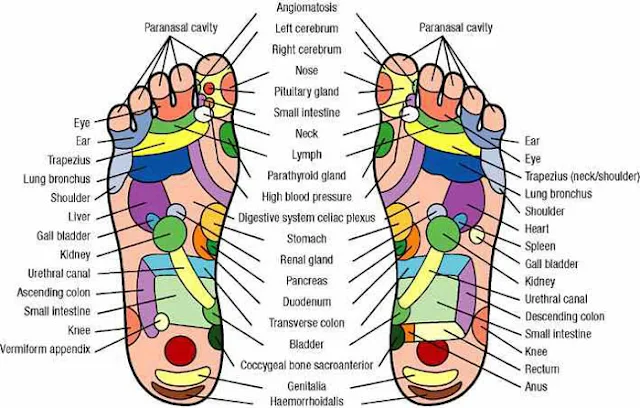What if I told you that a simple foot massage could improve your liver health or relieve a sore neck? You might be skeptical—and that’s understandable. How could massaging pressure points in your feet impact other parts of your body? If you’re not skeptical, you might be surprised, or perhaps you’ve already heard of reflexology.
Reflexology is a therapeutic practice that promotes pain relief and overall health by stimulating specific pressure points on the feet and hands. While many people visit professional reflexologists, you can also experience its benefits at home. Let’s explore how reflexology works, its health benefits, and how you can perform it yourself.
How Does Reflexology Work?

Reflexology is based on the concept that specific “zones” or reflex areas on the hands and feet correspond to organs, glands, and systems throughout the body.
By applying pressure to these areas with specific thumb, finger, and hand techniques, reflexology is believed to reduce stress, which can encourage positive physiological changes in the body. These changes may alleviate a range of ailments.
Research supports this connection. For example, randomized clinical trials have found reflexology effective for managing conditions such as diabetes, premenstrual syndrome, cancer, multiple sclerosis, overactive bladder, and dementia.
The Benefits of Foot Reflexology
Beyond addressing medical conditions, reflexology can also enhance the well-being of relatively healthy individuals. Here are some of its benefits:
- Stimulates nerve function
- Boosts energy levels
- Improves circulation
- Aids in toxin elimination
- Prevents migraines
- Supports urinary tract health
- Speeds up recovery from injuries
- Treats sleep disorders
- Reduces depression
- Relieves pain
Additionally, reflexology enables you to target specific areas of the body using the same principles as acupressure.
How to Perform a Reflexology Foot Massagehttps://www.youtube-nocookie.com/embed/FZ9mOnXdQlo?si=wF68qyvQPB-Oy5mH?rel=0
Now that you understand how reflexology can benefit your health, let’s go through the steps to perform it yourself:
1. Get Comfortable
Sit on a sturdy chair and place one foot on the opposite knee for easy access. Keep your back straight to maintain good posture.
2. Identify Your Target Area
Refer to a reflexology foot chart (you can find one below or online). Locate the point on your foot corresponding to the part of your body you want to treat. For example, if you’re experiencing neck pain, find the area labeled “neck” on the chart.
3. Apply Pressure
Use the tip of your thumb to press and knead the target area deeply for 1–2 minutes. Switch feet and repeat the process on the opposite side.
4. Treat Additional Areas
Follow the same method for any other areas you wish to address.
5. Follow a Schedule
Perform this massage daily. To maintain effectiveness, take a break after 10 consecutive days to allow your pressure points to reset. Rest for 3–4 days before resuming.
Start Your Reflexology Journey
If you’re dealing with aches, pains, or specific ailments, give foot reflexology a try. With consistent practice, you might notice improvements in your overall health and well-being. Have you tried reflexology?

Share your experience in the comments—we’d love to hear your thoughts!
Casei-me com o amigo do meu pai – Fiquei chocada quando vi o que ele começou a fazer na nossa noite de núpcias

Amber desistiu do amor, mas faíscas voam quando ela conhece o velho amigo de seu pai, Steve, em um churrasco. Enquanto seu romance relâmpago leva ao casamento, tudo parece perfeito. Mas na noite de núpcias, Amber descobre que Steve tem um segredo perturbador que muda tudo.
Parei na casa dos meus pais e olhei para a fila de carros estacionados no gramado.
“Do que se trata tudo isso?”, murmurei, já me preparando para qualquer surpresa familiar que me esperava lá dentro.

Uma mulher em seu carro | Fonte: Midjourney
Peguei minha bolsa, tranquei o carro e fui em direção à casa, torcendo para que não fosse nada muito caótico.
Assim que abri a porta, o cheiro de carne grelhada me atingiu, junto com o som da risada estrondosa do meu pai. Entrei na sala de estar e espiei pela janela dos fundos.
Claro, papai estava organizando algum tipo de churrasco improvisado. O quintal inteiro estava cheio de pessoas, a maioria delas da oficina mecânica dele.

Pessoas em um churrasco | Fonte: Pexels
“Amber!” A voz do papai cortou meus pensamentos enquanto ele virava um hambúrguer com o mesmo avental que ele tem há anos. “Vamos, pegue uma bebida e junte-se a nós. São só os caras do trabalho.”
Tentei não gemer. “Parece que a cidade inteira está aqui”, murmurei, tirando os sapatos.
Antes que eu pudesse me juntar à atmosfera familiar e caótica, a campainha tocou. Papai jogou a espátula no chão e limpou as mãos no avental.

Um homem entrando em uma casa | Fonte: Midjourney
“Deve ser Steve”, ele disse, quase para si mesmo. Ele olhou para mim enquanto alcançava a maçaneta. “Você ainda não o conheceu, certo?”
Antes que eu pudesse responder, papai já tinha aberto a porta.
“Steve!” ele rugiu, dando um tapinha firme nas costas do sujeito. “Entre, você chegou bem na hora. Ah, e conheça minha filha, Amber.”
Olhei para cima e meu coração disparou.

Um homem parado na soleira de uma porta | Fonte: Midjourney
Steve era alto e um pouco áspero nas bordas de uma forma rudemente bonita, com cabelos grisalhos e olhos que de alguma forma conseguiam ser quentes e profundos. Ele sorriu para mim, e eu senti uma estranha vibração no meu peito para a qual eu não estava preparada.
“Prazer em conhecê-la, Amber”, ele disse, oferecendo a mão.
Sua voz era calma e firme. Apertei sua mão, um pouco constrangido sobre como eu deveria parecer depois de dirigir por horas.
“Prazer em te conhecer também.”

Uma mulher | Fonte: Midjourney
Daquele ponto em diante, não consegui parar de olhar para ele. Ele era o tipo de homem que deixava todos ao redor confortáveis, sempre ouvindo mais do que falando. Tentei me concentrar nas conversas ao meu redor, mas toda vez que nossos olhos se encontravam, eu sentia essa atração.
Era ridículo. Eu nem pensava em amor ou relacionamentos há eras. Não depois de tudo que passei.
Eu tinha praticamente desistido de encontrar “a pessoa certa” e estava mais focada no trabalho e na família. Mas algo sobre Steve me fez querer reconsiderar, mesmo que eu não estivesse pronta para admitir.

Uma mulher atenciosa | Fonte: Midjourney
Conforme o dia foi passando, finalmente me despedi e fui para o meu carro. Claro, quando tentei ligá-lo, o motor engasgou e morreu.
“Ótimo”, eu gemi, afundando-me no meu assento. Pensei em voltar para dentro e pedir ajuda ao papai, mas antes que eu pudesse, houve uma batida na minha janela.
Era o Steve.
“Problemas com o carro?”, ele perguntou, sorrindo como se esse tipo de coisa acontecesse todo dia.

Um homem sorridente | Fonte: Midjourney
Eu suspirei. “É, não está pegando. Eu ia só buscar meu pai, mas…”
“Não se preocupe com isso. Deixe-me dar uma olhada”, ele ofereceu, já arregaçando as mangas.
Eu o observei trabalhar, suas mãos se movendo com facilidade praticada. Em poucos minutos, meu carro rugiu de volta à vida. Eu nem tinha percebido que estava prendendo a respiração até que exalei.

Um motor de carro | Fonte: Pexels
“Pronto”, ele disse, limpando as mãos em um pano. “Deve estar bom agora.”
Sorri, genuinamente grata. “Obrigada, Steve. Acho que te devo uma.”
Ele deu de ombros e me lançou um olhar que fez meu estômago revirar. “Que tal um jantar? Podemos ficar quites.”
Eu congelei por um segundo. Jantar? Ele estava me chamando para sair?

Um homem sorridente | Fonte: Midjourney
Senti aquela familiar centelha de dúvida, a vozinha no fundo da minha cabeça me lembrando de todos os motivos pelos quais eu não deveria dizer sim. Mas algo nos olhos de Steve me fez querer arriscar.
“Sim, o jantar parece bom.”
E assim, de repente, eu concordei. Eu nunca teria imaginado então que Steve era exatamente o homem que eu precisava para curar meu coração ferido… ou o quão profundamente ele me machucaria, também.

Uma mulher | Fonte: Midjourney
Seis meses depois, fiquei em frente ao espelho no meu quarto de infância, me olhando em um vestido de noiva. Foi surreal, honestamente. Depois de tudo que passei, não achei que esse dia chegaria.
Eu tinha 39 anos e desisti de todo esse conto de fadas, mas aqui estava eu — prestes a me casar com Steve.
O casamento foi pequeno, apenas familiares próximos e alguns amigos, exatamente o que queríamos.

Um local para casamento | Fonte: Pexels
Lembro-me de estar de pé no altar, olhando nos olhos de Steve, e sentindo essa sensação avassaladora de calma. Pela primeira vez em muito tempo, eu não estava duvidando de nada.
“Sim”, sussurrei, mal conseguindo conter as lágrimas.
“Sim”, Steve respondeu, com a voz carregada de emoção.
E assim, de repente, nos tornamos marido e mulher.

Um casal recém-casado | Fonte: Pexels
Naquela noite, depois de todos os parabéns e abraços, finalmente tivemos um tempo sozinhos. A casa de Steve, nossa casa agora, estava quieta, os cômodos ainda eram desconhecidos para mim. Deslizei para o banheiro para trocar de roupa para algo mais confortável, meu coração cheio e leve.
Mas no minuto em que voltei para o quarto, fui recebido por uma visão chocante.
Steve estava sentado na beirada da cama, de costas para mim, falando baixinho com alguém… alguém que não estava ali!

Um homem falando com alguém | Fonte: Midjourney
Meu coração deu um pulo.
“Eu queria que você visse isso, Stace. Hoje foi perfeito… Eu só queria que você pudesse estar aqui.” Sua voz era suave, cheia de emoção.
Fiquei paralisado na porta, tentando entender o que estava ouvindo.
“Steve?” Minha voz soou baixa, insegura.
Ele se virou lentamente, com a culpa brilhando em seu rosto.

Um homem assustado | Fonte: Midjourney
“Amber, eu—”
Cheguei mais perto, o ar entre nós estava pesado com palavras não ditas. “Com quem… com quem você estava falando?”
Ele respirou fundo, seus ombros caíram. “Eu estava falando com Stacy. Minha filha.”
Olhei para ele, o peso de suas palavras lentamente afundando. Ele me disse que teve uma filha. Eu sabia que ela tinha morrido. Mas eu não sabia sobre… isso.

Uma mulher preocupada | Fonte: Midjourney
“Ela morreu em um acidente de carro, com a mãe”, ele continuou, com a voz tensa. “Mas às vezes eu falo com ela. Sei que parece loucura, mas eu só… sinto que ela ainda está aqui comigo. Especialmente hoje. Eu queria que ela soubesse sobre você. Eu queria que ela visse o quão feliz eu sou.”
Eu não sabia o que dizer. Meu peito estava apertado e eu não conseguia recuperar o fôlego. A tristeza de Steve era crua, uma coisa viva entre nós, e fazia tudo parecer pesado.
Mas eu não me senti assustada. Eu não me senti brava. Só… tão triste. Triste por ele, por tudo que ele perdeu, e pela maneira como ele estava carregando tudo sozinho. Sua dor me machucou como se fosse minha.

Um homem triste | Fonte: Midjourney
Sentei-me ao lado dele, minha mão encontrando a dele. “Eu entendo”, eu disse suavemente. “Eu entendo. Você não é louco, Steve. Você está de luto.”
Ele soltou um suspiro trêmulo, olhando para mim com tanta vulnerabilidade que quase partiu meu coração. “Sinto muito. Eu deveria ter te contado antes. Eu só não queria te assustar.”
“Você não está me assustando”, eu disse, apertando sua mão. “Todos nós temos coisas que nos assombram. Mas estamos juntos nisso agora. Podemos levar isso adiante juntos.”

Uma mulher séria | Fonte: Midjourney
Os olhos de Steve se encheram de lágrimas, e eu o puxei para um abraço, sentindo o peso de sua dor, seu amor, seu medo, tudo isso reunido naquele momento.
“Talvez… talvez possamos conversar com alguém sobre isso. Um terapeuta, talvez. Não precisa mais ser só você e Stacy.”
Ele assentiu contra meu ombro, apertando-me mais forte. “Eu pensei sobre isso. Só não sabia como começar. Obrigado por entender, Amber. Eu não sabia o quanto precisava disso.”

Um homem emocional | Fonte: Midjourney
Eu me afastei o suficiente para olhá-lo nos olhos, meu coração inchando com um amor mais profundo do que eu já havia conhecido. “Nós vamos descobrir, Steve. Juntos.”
E quando o beijei, eu sabia que iríamos. Não éramos perfeitos, mas éramos reais, e pela primeira vez, isso pareceu o suficiente.
Mas é isso que acontece com o amor, não é? Não se trata de encontrar uma pessoa perfeita sem cicatrizes; trata-se de encontrar alguém cujas cicatrizes você esteja disposto a compartilhar.

Um casal de mãos dadas | Fonte: Pexels
Aqui vai outra história: o mundo de Emma se despedaça quando a ex de Steve, Susan, interrompe a cerimônia para anunciar que está morrendo e implorar para que Steve passe os últimos seis meses com ela. Chocada e traída, Emma exige respostas, apenas para descobrir que Steve está dividido entre seu passado e o futuro deles. Clique aqui para continuar lendo.
Este trabalho é inspirado em eventos e pessoas reais, mas foi ficcionalizado para fins criativos. Nomes, personagens e detalhes foram alterados para proteger a privacidade e melhorar a narrativa. Qualquer semelhança com pessoas reais, vivas ou mortas, ou eventos reais é mera coincidência e não intencional do autor.
O autor e a editora não fazem nenhuma reivindicação quanto à precisão dos eventos ou à representação dos personagens e não são responsáveis por nenhuma interpretação errônea. Esta história é fornecida “como está”, e quaisquer opiniões expressas são as dos personagens e não refletem as opiniões do autor ou da editora.



Leave a Reply